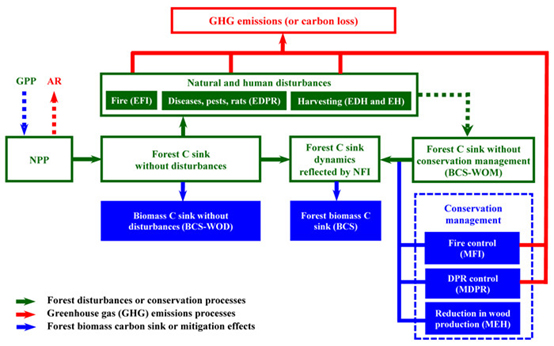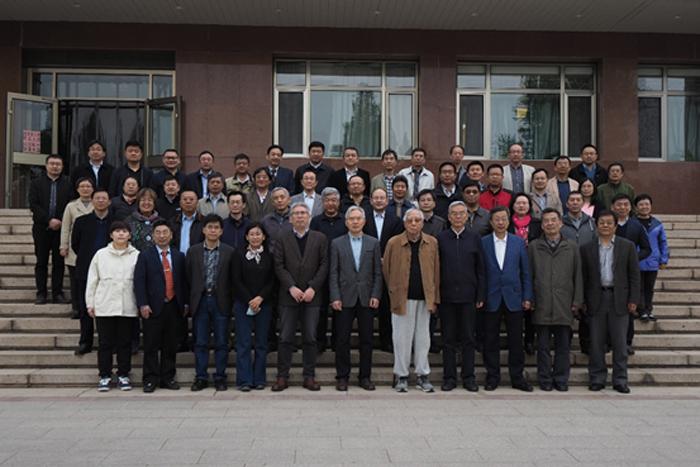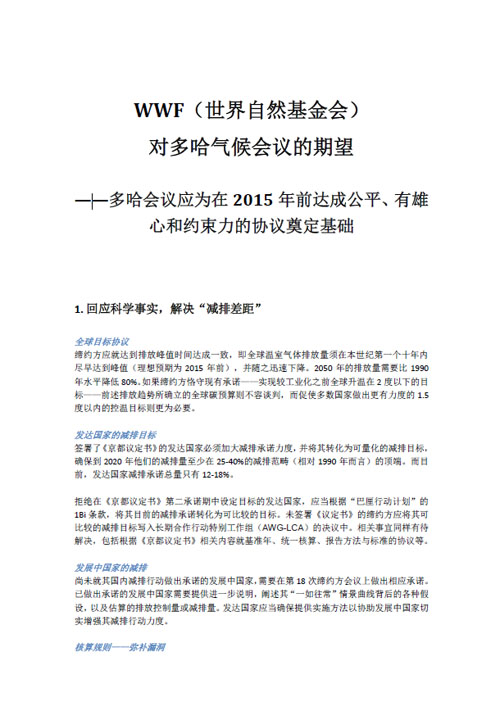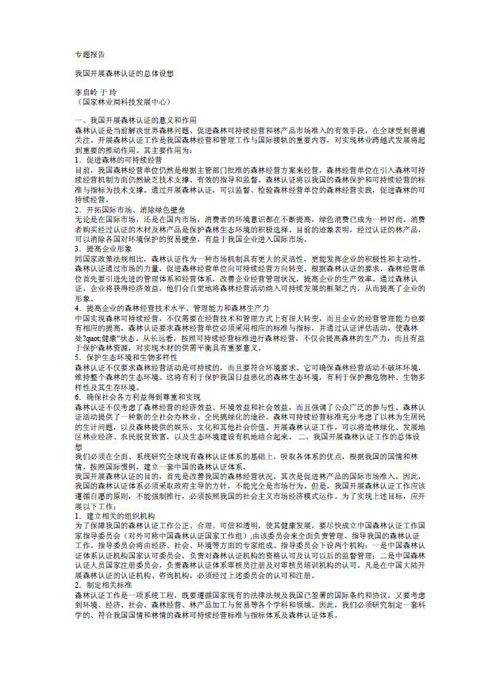
陆地生态系统扰动与碳循环模拟研究进展
编号
lyqk004517


中文标题
陆地生态系统扰动与碳循环模拟研究进展


作者单位
环境保护部信息中心,北京 100029;中国科学院地理科学与资源研究所,北京 100101


期刊名称
世界林业研究


年份
2014


卷号
27


期号
4


栏目编号
1


栏目名称
专题论述


中文摘要
陆地生态系统扰动(火灾、病虫害、氮沉降、极端气候事件等)可以极大影响并改变生态系统的功能与结构,进而对陆地碳循环的时空格局产生重要影响。定量估算自然扰动对陆地生态系统的影响对于深入理解陆地生态系统循环过程具有十分重要的科学意义。文中针对几种主要陆地生态系统自然扰动(火灾、虫害、氮沉降、干旱和洪水等)分析扰动过程与陆地碳收支动态变化的关系,并在此基础上综述近年来相关研究的主要进展,总结生态系统扰动过程的主要研究方法和各自特点,重点介绍运用生态系统过程模型方法研究陆地生态系统对各种扰动过程的响应,分析当前相关研究中存在的主要问题和不确定性,最后对该领域的未来发展方向进行了展望。


关键词
陆地生态系统
扰动
碳循环
气候变化
生态系统过程模型


基金项目
中国科学院知识创新工程重要方向资助项目(KZCX2-YW-432)


英文标题
Review on Terrestrial Ecosystem Disturbances and Carbon Cycle Modeling


作者英文名
Yang Yi and Tao Bo


单位英文名
China Environmental Information Center,Beijing 100029,China;Institute of Geographic Sciences and Natural Resources Research,Chinese Academy of Science,Beijing 100101,China


英文摘要
Terrestrial ecosystems disturbances (fires, diseases and pests, nitrogen deposition, extreme climate events, etc.) could profoundly alter ecosystem functions and structures, and therefore affect significantly key processes and factors controlling the terrestrial carbon cycle. Quantitative estimation on the impact of natural disturbances on terrestrial ecosystem is scientifically crucial to improve our understanding of terrestrial carbon processes. In this paper, we analyzed the relationship between the distribution processes and the dynamics of terrestrial carbon cycle in reference with main terrestrial ecosystem distributions (wildfire, pests, nitrogen deposition, flooding, drought, etc.), reviewed the progress of the research in recent years, introduced the research on the response of terrestrial ecosystem to various disturbance processes using ecosystem modeling, and analyzed the main challenges and uncertainties in the related research. Finally, the future research orientation was prospected.


英文关键词
terrestrial ecosystem;disturbance;carbon cycle;climate change;ecosystem modeling


起始页码
1


截止页码
5


投稿时间
2014/3/27


分类号
Q142;Q146


DOI
10.13348/j.cnki.sjlyyj.2014.04.001


参考文献
[1] White P S, Pickett S T A. Natural disturbance and patch dynamics: an introduction[M]//Pickett S T A, White P S(eds). The ecology of natural disturbance and patch dynamics. New York: Academic Press,1985: 3-13.
[2] Turner M G., Dale V H. Comparing large, infrequent disturbances: what have we learned ? [J]. Ecosystems, 1998, 1(6): 493-496.
[3] Turner M G, Collins S L, Lugo A L,et al. Disturbance dynamics and ecological response:the contribution of long-term ecological research[J]. Bioscience, 2003,53(1):46-56.
[4] Melillo J M,McGuire A D,Kick lighter D W,et al. Global climate change and terrestrial net primary production[J]. Nature, 1993,363(20):234-240.
[5] Paul K I, Po lglase P J, Smethurst P J, et al. Soil temperature under forests: a simple model forp redicting soil temperature under a range of forest types[J]. Agricultural and Forest Meteorology, 2004,121(3/4):167-182.
[6] Kang S, Kim S, Oh S, et al. Predicting spatial and temporal patterns of soil temperature based on topography, surface cover and air temperature[J]. Forest Ecology and Management, 2000, 136(1/2/3):173-184.
[7] Andersson M, Michelsen A, Jensen M, et al. Tropical savanna woodland: effects of experimental fire on soil microorganisms and soil emissions of carbon dioxide[J]. Soil Biology & Biochemistry, 2004,36(5):849-858.
[8] Kasischke E S, Bruhwiler L P. Emissions of carbon dioxide, carbon monoxide, and methane from boreal forest fires in 1998[J]. Journal of Geophysical Research:Atmospheres, 2003,107(D1).doi:10.1029/2001JD000461.
[9] Li C, Flannigan M D, Corns I G W. Influence of potential climate change on forest landscape dynamics of west Ocentral Alberta[J]. Canadian Journal of Forest Research, 2000,30(12): 1905-1912.
[10] Dale V H, Joyce L A, Mcnulty S, et al. Climate change and forest disturbance[J]. BioScience, 2001,51(9):723-734.
[11] Aber J, Melillo J M. Terrestrial Ecosystems[M]. San Diego, USA:Academic Press,2001.
[12] Neff J C, Townsend A R, Gleixner G, et al.Variable effects of nitrogen additions on the stability and turnover of organic carbon[J].Nature, 2002,419:915-917.
[13] Casperson J P, Pacala S W, Jenkins J C, et al. Contributions of land use history to carbon accumulation in US forests[J].Science, 2000,290(5494):l148-1151.
[14] Clark K L,Skowronski N,Hom J. Invasive insects impact forest carbon dynamics[J]. Global Change Biology, 2010, 16(1):88-101.
[15] Nepstad D, Lefebvre P, Silva U L D, et al. Amazon drought and its implications for forest flammability and tree growth: a basin-wide analysis[J]. Global Change Biology, 2004,10(5):704-717.
[16] Breshears D D, Allen C D. The importance of rapid, disturbance induced losses in carbon management and sequestration[J]. Global Ecology and Biogeography, 2002,11(1):1-5.
[17] Yin Y, Wu Y G,Bartellb S M,et al. Patterns of forest succession and impacts of flood in the Upper Mississippi River floodplain ecosystem[J]. Ecological Complexity, 2009,6(4):463-472.
[18] Seiler W, Crutzen P J. Estimates of gross and net fluxes of carbon between the biosphere and the atmosphere from biomass burning[J]. Climate Change, 1980, 2(3):207-248.
[19] French N H F, Kasischke E S, Lee B S, et al. Carbon released from fires in North American boreal forests [M]//Kasischke E S,Stocks B J.Fire,climate change and carbon cycling in North American boreal forests. New York: Springer, 2000: 377-388.
[20] Hicke J A, Asner G P, Kasischke E S, et al.Postfire response of North American boreal forest net primary productivity analyzed with satellite observations[J]. Global Change Biology, 2003, 9(8):1145-1157.
[21] Zhuang Q L, McGuire A D, O'neill K P, et al.Modeling soil thermal and carbon dynamics of a fire chrono sequence in interior Alaska[J]. Journal of Geophysical Research, 2003,107(D1).doi:10.1029/2001JD001244.
[22] Goetz S J, G J Fiske, Andrew G Bunn. Using satellite time-series data sets to analyze fire disturbance and forest recovery across Canada[J]. Remote Sensing of Environment, 2006, 101(3):352- 365.
[23] Knapp A K, Fay P A,Blair J M,et al. Rainfall variability, carbon cycling, and plant species diversity in a mesic grassland[J]. Science, 2002, 298(5601):2202-2205.
[24] Townsend A R,Braswel B H,Houand E A,et al.Spatial and temporal patterns in terrestrial carbon storage due to deposition of anthropogenic nitrogen[J].Ecological Applications, 1996, 6(3):806-814.
[25] Holland E A, Braswell B H, Lamarque J F, et al. Variations in the predicted spatial distribution of atmospheric nitrogen deposition and their impact on carbon uptake by terrestrial ecosystems[J]. Journal of Geophysical Research, 1997,102(D13): 15849-15866.
[26] Weltzin J F, Loik M E, Schwinning S, et al. Assessing the response of terrestrial ecosystems to potential changes in precipitation[J]. BioScience, 2003, 53(10):941-952.
[27] Cao M K, Prince S D, Shugart H H. Increasing terrestrial carbon uptake from the 1980s to the 1990s with changes in climate and atmosphere CO2[J]. Global Biogeochemical Cycles, 2002, 16(4).doi:10.1029/2001GB001553.
[28] Tian H Q, Melillo J M, Kicklighter D W, et al. The sensitivity of terrestrial carbon storage to historical climate variability and atmospheric CO2 in the United States[J]. Tellus, 1999, 51(2): 414-452.
[29] Running S W. Ecosystem disturbance, carbon, and climate[J]. Science, 2008, 321(5889): 652-653.


PDF全文
浏览全文


-
相关记录
更多
- 火干扰对森林凋落物分解的影响研究进展 2023
- 推动“双碳”目标实现的林业碳汇科学传播策略 2023
- 气候变化对森林树种分布信息和地上生物量的影响 2022
- 美国引导林农参与碳市场的经验及启示 2022
- 黄河上游玛曲段高寒草地沙化现状、成因及防治对策 2024
- 持续高温晴热天气对武汉市区园林植物的影响 2023
 打印
打印







